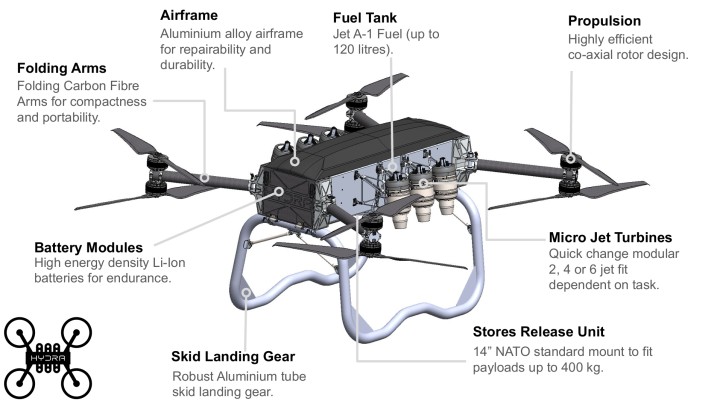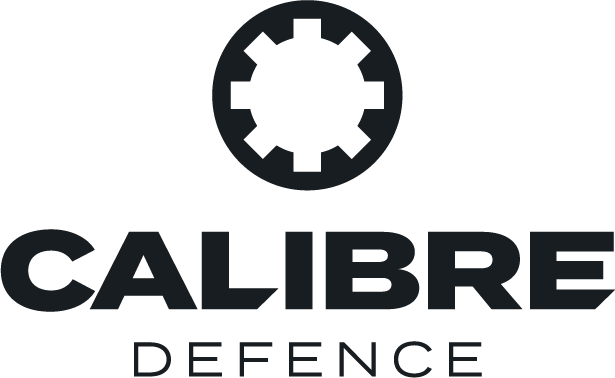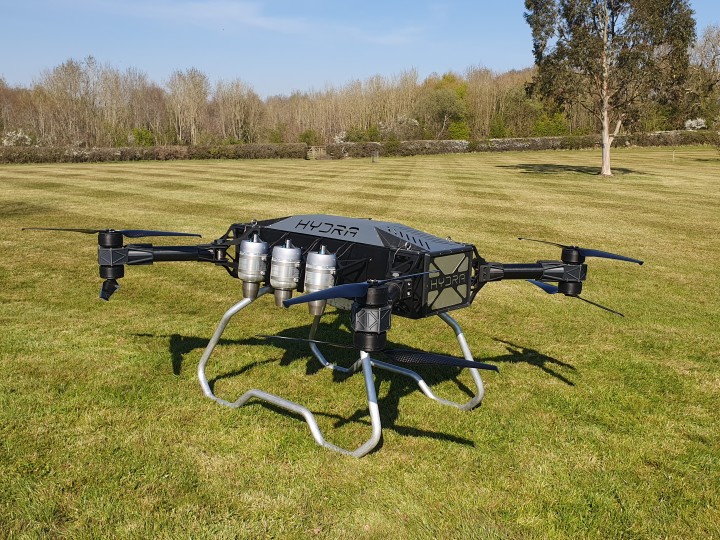MBDA invests in the UK’s Hydra Drones
MBDA has invested in Hydra Drones, a British SME that designs and builds hybrid drones powered by a combination of jet and electric power, according to a 28th April press release.
With the investment, MBDA becomes a shareholder in Hydra Drones Ltd, and the two companies will continue the development of the Hydra 400 heavy lift drone through their ongoing partnership. The investment builds upon past cooperation, including a display at DSEI in 2023, which saw the Hydra 400 armed with a mockup of three Brimstone missiles, the 50 kg anti-armour weapon developed by MBDA. The partnership will continue the integration of MBDA effectors onto the Hydra 400, the press release states.
“Our original collaboration with MBDA was a great validation of our agile and innovative technological approach, this further investment in our business means more than just financial backing. It allows us to meaningfully contribute to national defence capabilities while keeping our high-skilled workforce local,” Dr Stephen Prior, CEO of Hybrid Drones Ltd, said.
“We owe a great deal to the Army’s Land Industrial Strategy for our successful collaboration with MBDA”, Dr Stephen Prior commented further. “Long-term collaboration between the Army and industry is vital to the work we do, and as a home-grown UK SME.”
Hydra Drones is fairly early in terms of its funding, having secured close to £1 million from family and friends, as well as members of the armed forces and private investors. This means that the company will likely work with MBDA to focus on securing initial orders and establishing a pipeline for the product that can be used as the basis to secure further investment.
Tech profile: Hydra 400

This graphic shows the location and key elements of the Hydra 400. Credit: Hydra Drones
The Hydra 400 uses a hybrid of electric rotors and single spool jet turbines for lift and propulsion. Each jet engine provides up to 50 kg of thrust, meaning that the variant with six jets and four rotors can provide up to 400 kg of lift capability, Hydra Drones states. It can be configured with just electric motors if required, and two, four, or six jet engines. With a full payload, the Hydra 400 is stated to have an endurance of 25 minutes, which is presumably increased with lighter payloads.
It is fitted with the Gnat stores release system from L3Harris, which enables it to carry casualty evacuation pods, supplies, or weapons. Hydra 400 can be transported in the back of a flatbed truck and assembled ready for flight in minutes.
It was described as semi-attritable by the company’s managing director, Tom O’Connor, speaking to the Telegraph. This means it will not “cost crazy money”, O’Connor said.
Calibre comment
Heavy-lift drones are seen by some as a valid replacement for conventional helicopters, especially when they can carry significant payloads like the Hydra 400. Armed with missiles they could potentially provide a strike platform, although the speed and range of an attack helicopter are important enablers of their strike capabilities. Nevertheless, heavy strike drones have proven very effective in Ukraine, driving survivability adaptations on both sides, especially when used to deploy mines or mortar bombs.
However, this type of drone is typically large and loud. Russian snipers have shown the ability to shoot Ukraine’s Baba Yagas (a large heavy lift drone) down using rifles. The large size would also make them a more viable target for airbursting medium calibre ammunition and other, more expensive anti-drone weapons, which smaller drones might not.
By Sam Cranny-Evans, published on 28th April, 2025.

Sign Up for Updates!
Get insider news, tips, and updates. No spam, just the good stuff!






